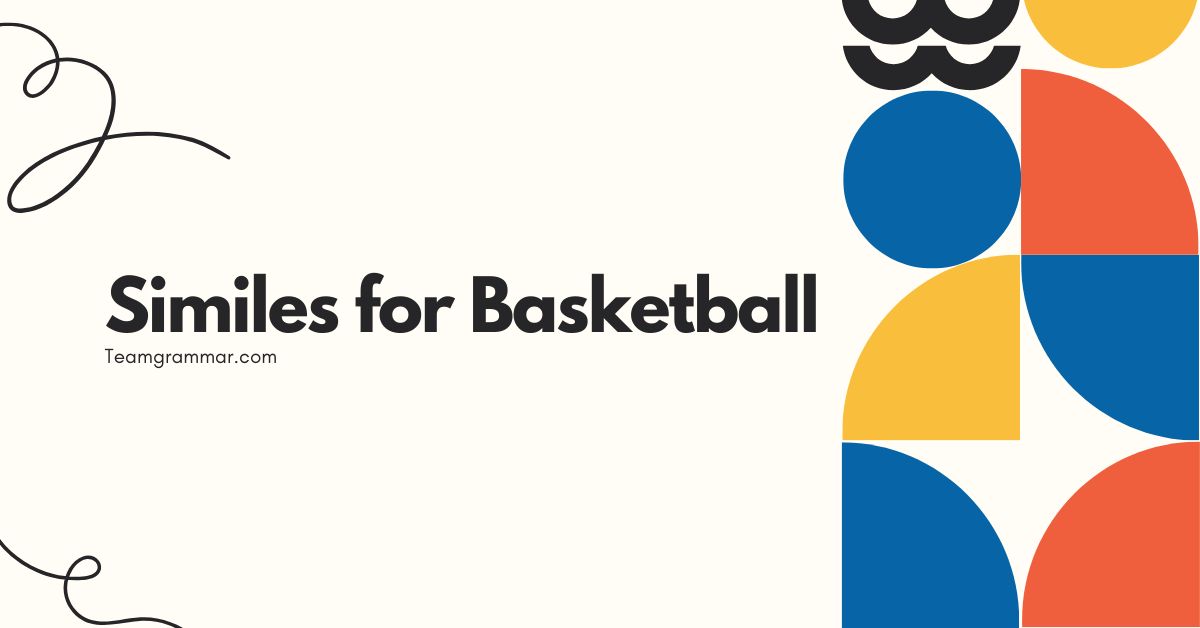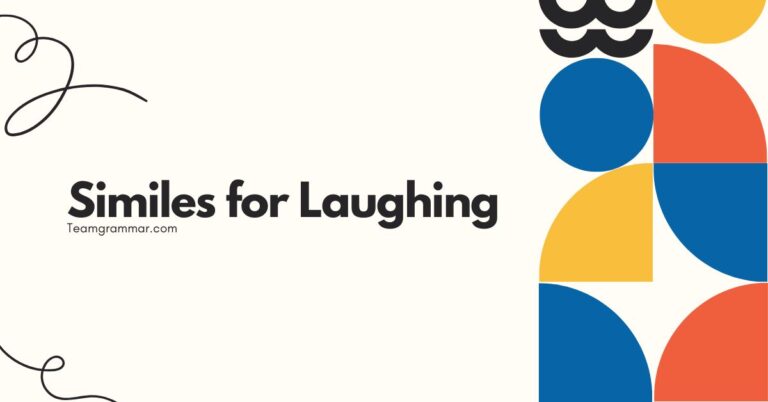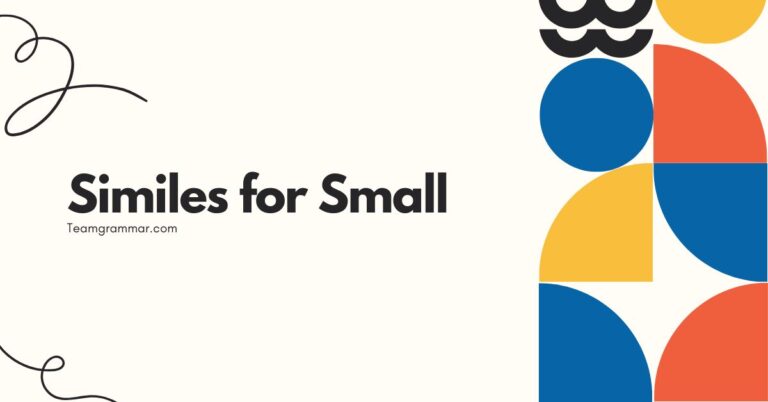43 Similes for Basketball: A Grammatical Slam Dunk
Understanding similes is crucial for enhancing both your writing and comprehension skills. In English grammar, similes add color and vividness to descriptions by comparing one thing to another using “like” or “as.” This article delves into the world of basketball similes, exploring their structure, usage, and impact.
Whether you’re a student, writer, or simply an avid sports enthusiast, this guide will provide you with the knowledge and tools to master similes in the context of basketball.
Table of Contents
- Introduction
- Definition of Simile
- Structural Breakdown of Similes
- Types of Basketball Similes
- Examples of Basketball Similes
- Usage Rules for Similes
- Common Mistakes with Similes
- Practice Exercises
- Advanced Topics: Metaphor vs. Simile
- Frequently Asked Questions
- Conclusion
Definition of Simile
Asimileis a figure of speech that directly compares two different things using the words “like” or “as.” The purpose of a simile is to create a vivid image or enhance understanding by drawing a parallel between the characteristics of two distinct entities. Similes are essential tools in descriptive writing, allowing authors to paint a clearer and more engaging picture for the reader.
They are also very effective in spoken language, adding emphasis and flair to everyday conversations.
Unlike metaphors, which state that one thing is another, similes acknowledge the comparison using “like” or “as.” This explicit comparison makes similes more direct and often easier to understand. For example, saying “He shoots like Steph Curry” is a simile, while saying “He is the Steph Curry of our team” is a metaphor.
Similes can be classified based on the aspect of comparison they highlight. They can describe appearance, behavior, sound, or any other attribute.
The effectiveness of a simile depends on the clarity and relevance of the comparison. A well-chosen simile can transform a mundane description into something memorable and impactful.
Classification of Similes
Similes can be classified based on the attribute they emphasize. These classifications aren’t mutually exclusive, but they help understand the nuances of simile creation.
- Appearance Similes: These compare how something looks. Example: “The basketball was as orange as a sunset.”
- Behavior Similes: These compare actions or conduct. Example: “He moved on the court like a panther.”
- Sound Similes: These compare the noises produced. Example: “The buzzer sounded like a roaring lion.”
- Quality Similes: These compare general attributes or characteristics. Example: “His determination was as strong as steel.”
- Emotional Similes: These compare feelings or emotional states. Example: “His disappointment felt like a crushing defeat.”
Function of Similes
The primary function of similes is to enhance descriptive writing and speech. They make descriptions more vivid, relatable, and engaging by drawing comparisons to familiar concepts or images.
Similes can also clarify complex ideas by relating them to simpler, more understandable terms. Furthermore, they add depth and nuance to writing, allowing authors to convey subtle meanings and emotions.
In persuasive writing, similes can be used to sway the reader’s opinion by associating a subject with something positive or negative. In creative writing, they contribute to the overall aesthetic appeal and artistic expression.
The strategic use of similes can elevate the quality of any piece of writing or speech.
Contexts of Similes
Similes are used in a wide variety of contexts, from literature and poetry to everyday conversations and advertising. In literature, they are often used to create imagery, develop characters, and enhance the overall theme of a story.
In poetry, they contribute to the rhythm, sound, and emotional impact of the verse. In everyday conversations, similes add color and expressiveness to our speech.
In advertising, similes are used to make products more appealing by associating them with desirable qualities. For instance, a basketball shoe might be described as being “as light as a feather” to emphasize its comfort and agility.
The versatility of similes makes them a valuable tool in any communication setting.
Structural Breakdown of Similes
A simile typically consists of three key components: the subject, the linking word, and the referent. Understanding these components is crucial for constructing effective and meaningful similes.
- Subject: The subject is the thing being described or compared. In the context of basketball, this could be a player, a ball, a move, or any other element of the game.
- Linking Word: The linking word is either “like” or “as.” These words explicitly indicate that a comparison is being made.
- Referent: The referent is the thing to which the subject is being compared. It should be something familiar or easily understood by the audience.
The basic formula for a simile is: Subject + Linking Word + Referent. For example, in the simile “He runs like the wind,” “He” is the subject, “like” is the linking word, and “the wind” is the referent.
The effectiveness of a simile depends on the relationship between the subject and the referent. The comparison should be clear, relevant, and impactful.
Avoid using clichés or overused similes, as they can detract from the originality and effectiveness of your writing.
Patterns of Similes
Similes often follow specific patterns that enhance their clarity and impact. These patterns can involve different grammatical structures and stylistic choices.
- Subject + Verb + Like/As + Referent: This is the most common pattern. Example: “He shoots like a pro.”
- Subject + Is/Was + Like/As + Adjective + Referent: This pattern emphasizes a specific quality. Example: “His jump was as high as a skyscraper.”
- Subject + Adjective + Like/As + Referent: This pattern uses an adjective to describe the subject. Example: “Quick like a viper, he stole the ball.”
These patterns provide a framework for constructing similes, but they can be adapted and modified to suit your specific needs. The key is to maintain clarity and relevance in your comparison.
Rules of Similes
While similes are relatively straightforward, there are some basic rules to keep in mind when using them.
- Use “like” or “as” to signal a comparison. These words are essential for distinguishing similes from metaphors.
- Ensure the comparison is logical and relevant. The subject and referent should share a common characteristic.
- Avoid clichés and overused similes. Strive for originality and creativity in your comparisons.
- Consider your audience. Choose referents that are familiar and easily understood by your readers or listeners.
By following these rules, you can create effective and impactful similes that enhance your writing and communication.
Types of Basketball Similes
Basketball similes can be categorized based on the specific aspects of the game they describe. These categories include player attributes, ball movement, game situations, and overall performance.
Player Attributes Similes
These similes describe the physical and mental characteristics of basketball players. They can relate to speed, agility, strength, skill, and determination.
Examples include:
- “He’s as quick as a cat on the court.”
- “His hands are like glue when he catches the ball.”
- “She’s as tough as nails under the basket.”
- “His vision is like an eagle, spotting open teammates.”
Ball Movement Similes
These similes describe how the basketball moves during the game. They can relate to passing, dribbling, shooting, and rebounding.
Examples include:
- “The ball zipped through the air like a bullet.”
- “He dribbled the ball like it was an extension of his hand.”
- “The rebound came off the rim like a rocket.”
- “His pass was as smooth as silk.”
Game Situations Similes
These similes describe specific moments or circumstances during a basketball game. They can relate to scoring, defending, fouling, and time management.
Examples include:
- “The tension in the arena was as thick as fog.”
- “The crowd roared like a pack of wolves after the buzzer-beater.”
- “The clock ticked down like a time bomb.”
- “The game was as close as a hair’s breadth.”
Overall Performance Similes
These similes describe the overall performance of a player or team. They can relate to success, failure, consistency, and improvement.
Examples include:
- “They played like a well-oiled machine.”
- “His performance was as consistent as a metronome.”
- “They crumbled under pressure like a house of cards.”
- “He rose to the occasion like a phoenix from the ashes.”
Examples of Basketball Similes
Here are several tables filled with examples of similes related to basketball. The examples are categorized to showcase the versatility of similes in describing different aspects of the sport.
The following table provides examples of similes focused on describing the physical attributes and skills of basketball players. These similes use comparisons to animals, objects, and other familiar concepts to create vivid images of player characteristics.
Player Attribute Similes Examples
| Simile | Category |
|---|---|
| He’s as quick as a cobra on the dribble. | Agility |
| Her jump shot is as smooth as silk. | Skill |
| He’s as strong as an ox in the paint. | Strength |
| His defense is as tight as a drum. | Defense |
| She moves like a gazelle on the court. | Agility |
| His passes are as precise as a laser beam. | Skill |
| He’s as relentless as a shark pursuing prey. | Determination |
| Her focus is as sharp as a razor. | Mental Toughness |
| His hands are like magnets when rebounding. | Rebounding |
| He towers over everyone else like a giant. | Height |
| He shoots like Steph Curry in his prime. | Shooting |
| He defends like a junkyard dog. | Defense |
| He’s as cool as a cucumber under pressure. | Mental Toughness |
| His dribbling is as mesmerizing as a dancer’s moves. | Dribbling |
| He’s as hungry as a wolf for the win. | Determination |
| She leaps like a salmon going upstream. | Vertical Jump |
| His shots are as consistent as clockwork. | Shooting |
| He’s as agile as a squirrel avoiding traffic. | Agility |
| His movements are as fluid as water. | Agility |
| He jumps as high as a skyscraper. | Vertical Jump |
| He controls the ball as if it were glued to his hand. | Ball Control |
| His drive to the basket is as powerful as a locomotive. | Driving Ability |
| He’s as quick as lightning on fast breaks. | Speed |
| His passes are as accurate as guided missiles. | Passing Accuracy |
The following table provides examples of similes that describe the movement and behavior of the basketball during a game. These similes compare the ball’s trajectory, speed, and interaction with different surfaces to familiar objects and actions.
Ball Movement Similes Examples
| Simile | Category |
|---|---|
| The ball soared through the air like an eagle. | Trajectory |
| It zipped through the net like a hot knife through butter. | Smoothness |
| The ball bounced off the rim like a rubber ball. | Rebound |
| It floated towards the basket like a feather. | Gentleness |
| The ball spun like a top in his hands. | Control |
| It smacked against the backboard like thunder. | Impact |
| The ball traveled like a comet across the court. | Speed |
| It was passed around like a hot potato. | Urgency |
| The ball dropped into the net like a raindrop. | Precision |
| It ricocheted off the backboard like a pinball. | Unpredictability |
| The ball flew like a rocket towards the hoop. | Speed |
| It wobbled in the air like a dying bird. | Instability |
| The ball landed in his hands like it was guided by a magnet. | Accuracy |
| It rolled around the rim like a lost marble. | Tension |
| The ball slipped through his fingers like water. | Loss of Control |
| It hit the net with a swish as clean as a whistle. | Clean Shot |
| The ball bounced high off the floor like a kangaroo. | Rebound |
| It sailed over the defender’s head like a kite. | Passing |
| It rotated in the air like a planet. | Spin |
| It moved around the court as fast as a cheetah. | Speed |
| It hit the floor and echoed like a drum. | Sound |
| The pass was as swift as an arrow. | Speed |
| It dropped through the net as silently as a shadow. | Quietness |
The table below showcases similes used to describe different game situations and the overall atmosphere of a basketball game. These similes use comparisons to intense natural phenomena, dramatic events, and familiar settings to convey the pressure, excitement, and competitive spirit of basketball.
Game Situation Similes Examples
| Simile | Category |
|---|---|
| The crowd roared like a thunderstorm after the dunk. | Crowd Reaction |
| The tension was as thick as fog in the final seconds. | Tension |
| The game was as intense as a battlefield. | Intensity |
| The buzzer sounded like a siren, signaling the end. | End of Game |
| The atmosphere was electric, like a live concert. | Atmosphere |
| The pressure mounted like a volcano about to erupt. | Pressure |
| The comeback felt like a miracle. | Comeback |
| The loss stung like a bee sting. | Defeat |
| The victory tasted as sweet as honey. | Victory |
| The silence after the missed shot was as deep as a grave. | Silence |
| The final moments dragged on like an eternity. | Time |
| The scoreboard lit up like a Christmas tree. | Scoreboard |
| The defensive wall was as impenetrable as a fortress. | Defense |
| The players moved like chess pieces on a board. | Strategy |
| The coach paced the sidelines like a caged tiger. | Coach |
| The arena was as loud as a rock concert. | Arena Noise |
| The feeling of winning was like floating on air. | Winning |
| The team worked together like a symphony orchestra. | Teamwork |
| The intensity of the game was as palpable as a physical weight. | Intensity |
| The suspense was as sharp as a knife. | Suspense |
| The arena was as packed as a can of sardines. | Crowd Density |
| The celebration was as wild as a jungle. | Celebration |
| The defeat was as devastating as a tidal wave. | Defeat |
Usage Rules for Similes
Using similes effectively involves understanding and adhering to certain rules that ensure clarity, relevance, and impact. These rules cover the choice of comparisons, the avoidance of clichés, and the consideration of audience.
Choosing Effective Comparisons
The key to a good simile is choosing a comparison that is both clear and relevant. The subject and referent should share a common characteristic that is easily recognizable.
The comparison should also enhance the reader’s understanding or create a vivid image.
For example, “He shoots like a machine” is an effective simile because it clearly conveys the player’s consistent and efficient shooting ability. However, “He shoots like a tree” is not effective because it lacks a clear and relevant connection between shooting and trees.
Avoiding Clichés and Overused Similes
Clichés are overused expressions that have lost their impact due to overuse. Avoid using clichés in your similes, as they can make your writing sound unoriginal and predictable.
Instead, strive for creativity and originality in your comparisons.
Examples of cliché similes include:
- “As strong as an ox”
- “As fast as lightning”
- “As quiet as a mouse”
Instead of using these clichés, try to come up with fresh and original comparisons that are specific to the context of basketball.
Considering Your Audience
When using similes, it’s important to consider your audience and choose referents that are familiar and easily understood by them. A simile that is effective for one audience may not be effective for another.
For example, if you are writing for a general audience, you should choose referents that are widely known and understood. If you are writing for a more specialized audience, such as basketball fans, you can use more specific and technical comparisons.
Common Mistakes with Similes
Even though similes are relatively straightforward, several common mistakes can undermine their effectiveness. These mistakes include confusing similes with metaphors, using illogical comparisons, and employing clichés.
Confusing Similes with Metaphors
The most common mistake is confusing similes with metaphors. Remember that similes use “like” or “as” to make a comparison, while metaphors directly equate two things without using these words.
| Incorrect (Metaphor) | Correct (Simile) |
|---|---|
| He is a machine on the court. | He plays like a machine on the court. |
| She is lightning on the fast break. | She is as fast as lightning on the fast break. |
Using Illogical Comparisons
Another common mistake is using comparisons that are illogical or nonsensical. The subject and referent should share a clear and relevant characteristic.
| Incorrect | Correct |
|---|---|
| He shoots like a bicycle. | He shoots like a marksman. |
| The ball bounces like a cloud. | The ball bounces like a golf ball. |
Using Cliche Similes
Using clichés or overused similes can detract from the originality and impact of your writing. Strive for fresh and creative comparisons.
| Incorrect (Cliche) | Correct (Original) |
|---|---|
| He’s as strong as an ox. | He’s as strong as a power forward battling for position. |
| She’s as fast as lightning. | She’s as fast as a point guard on a fast break. |
Practice Exercises
Test your understanding of similes with the following exercises. Fill in the blanks to complete the similes, or rewrite the sentences using similes.
Exercise 1: Fill in the Blanks
Complete the following sentences with appropriate similes.
| Question | Answer |
|---|---|
| 1. He dribbles the ball __________. | like a wizard. |
| 2. Her jump shot is as smooth __________. | as silk. |
| 3. The crowd roared __________. | like a lion. |
| 4. The ball flew through the air __________. | like an arrow. |
| 5. He defended __________. | like a bulldog. |
| 6. The tension was as thick __________. | as fog. |
| 7. She moved on the court __________. | like a dancer. |
| 8. His pass was as accurate __________. | as a laser. |
| 9. The buzzer sounded __________. | like a siren. |
| 10. The victory tasted __________. | as sweet as honey. |
Exercise 2: Rewrite with Similes
Rewrite the following sentences using similes to make them more descriptive.
| Original Sentence | Rewritten Sentence (with Simile) |
|---|---|
| 1. He is a skilled shooter. | He shoots like a pro. |
| 2. She is a fast runner. | She runs as fast as the wind. |
| 3. The arena was loud. | The arena was as loud as a rock concert. |
| 4. He’s a strong player. | He’s as strong as an ox. |
| 5. She is very focused. | Her focus is as sharp as a razor. |
| 6. He is very agile. | He’s as agile as a cat. |
| 7. The tension was high. | The tension was as thick as fog. |
| 8. The ball moved quickly. | The ball flew through the air like a bullet. |
| 9. He defends aggressively. | He defends like a junkyard dog. |
| 10. The victory was sweet. | The victory tasted as sweet as honey. |
Advanced Topics: Metaphor vs. Simile
While both similes and metaphors are figures of speech that make comparisons, they do so in different ways. Understanding the nuances between them is crucial for advanced learners.
A simile uses “like” or “as” to make an explicit comparison, stating that one thing is *similar* to another. A metaphor, on the other hand, implies a comparison by stating that one thing *is* another, without using “like” or “as.”
For example:
- Simile: “He’s as quick as a cheetah on the court.”
- Metaphor: “He’s a cheetah on the court.”
The metaphor is a more direct and forceful statement, while the simile is a more subtle and nuanced comparison. Both can be effective, but they convey slightly different meanings and create different effects.
Choosing between a simile and a metaphor depends on the specific context and the desired effect. Similes are often used to clarify or explain something, while metaphors are used to create a more vivid or emotional impression.
Frequently Asked Questions
Here are some frequently asked questions about similes, along with detailed answers.
- What is the difference between a simile and a metaphor?
A simile uses “like” or “as” to make a direct comparison, while a metaphor implies a comparison by stating that one thing *is* another without using these words. Similes are explicit, while metaphors are implicit.
- How do I create an effective simile?
Choose a comparison that is clear, relevant, and impactful. The subject and referent should share a common characteristic that is easily recognizable. Avoid clichés and consider your audience.
- Why are similes important in writing?
Similes enhance descriptive writing by creating vivid images and making descriptions more relatable and engaging. They can also clarify complex ideas and add depth and nuance to writing.
- What are some common mistakes to avoid when using similes?
Avoid confusing similes with metaphors, using illogical comparisons, and employing clichés. Ensure that your comparisons are clear, relevant, and original.
- Can similes be used in everyday conversation?
Yes, similes are used frequently in everyday conversation to add color and expressiveness to our speech. They can make our descriptions more vivid and engaging.
- Are there any rules about the length of a simile?
There are no strict rules about the length of a simile, but it should be concise and to the point. Avoid making your similes too long or convoluted, as this can detract from their effectiveness.
- How can I improve my ability to use similes effectively?
Practice using similes in your writing and speech. Pay attention to the similes used by other writers and speakers, and analyze why they are effective. Experiment with different comparisons and see what works best for you.
- What is the role of “like” and “as” in similes?
The words “like” and “as” are crucial for identifying similes. They explicitly signal that a comparison is being made between two different things. Without these words, the statement would likely be a metaphor or another figure of speech.
- How do cultural references affect the understanding of similes?
Cultural references can significantly impact how similes are understood. Similes that rely on specific cultural knowledge may not be universally understood, potentially leading to confusion or misinterpretation. It’s important to consider your audience’s cultural background when crafting similes.
- Can a simile be too obvious or too subtle?
Yes, a simile can be too obvious if the comparison is trite or lacks originality, diminishing its impact. Conversely, a simile can be too subtle if the connection between the subject and referent is too obscure, causing confusion. The key is to strike a balance that enhances understanding and adds color without being either predictable or incomprehensible.
Conclusion
Mastering similes is essential for enhancing your writing and communication skills. By understanding their structure, usage rules, and common pitfalls, you can effectively use similes to create vivid images, clarify complex ideas, and add depth to your descriptions.
Basketball provides a rich context for exploring similes, allowing you to describe the game’s dynamic action and intense atmosphere in creative and engaging ways.
Remember to choose comparisons that are clear, relevant, and original. Avoid clichés and consider your audience when crafting similes.
With practice and attention to detail, you can become proficient in using similes to elevate the quality of your writing and speech. Keep practicing and experimenting with different comparisons to find what works best for you.
Happy writing!







